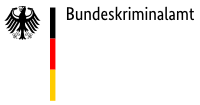
The experts for speaker identification and audio analysis are usually called in at a very early stage of the crime. About two thirds of their requests for examination are already received in the initial phase of police inquiries, for example during ongoing extortion or kidnap situations. In many cases the analysis of acoustic material is extremely important in order to gather the decisive clues needed to solve a criminal offence and to prevent follow-up offences.
Voice recordings and other acoustic material are usually available for scrutiny. On the one hand, the recordings are found on items of evidence seized, such as cassettes from answering or dictating machines, on the other hand on mostly digital sound storage media containing under-cover recordings or recordings from telecommunications surveillance. In the context of counter-terrorism, audio and video broadcasts are also examined.
 The expression “Bundeskriminalamt” in different phonetic-acoustic types of representation : Oscillogram, phonetic transcription, spectrogram, energy distribution and fundamental frequency curve.
The expression “Bundeskriminalamt” in different phonetic-acoustic types of representation : Oscillogram, phonetic transcription, spectrogram, energy distribution and fundamental frequency curve.
If the voice of an unidentified offender is available, for example a recorded telephone call from an extortionist, a kidnapper or someone claiming responsibility for an offence, then the law-enforcement authorities requesting the examination will soon receive the results of the BKA voice analysis, the so-called voice profile. This provides reliable statements about the age and sex of the anonymous speaker, his/her regional origin, language competence or social background.
 Workstation from the speaker identification and audio analysis section: The detailed auditory examination of speech recordings is carried out using high-quality audio equipment and is supported by digital signal analyses.
Workstation from the speaker identification and audio analysis section: The detailed auditory examination of speech recordings is carried out using high-quality audio equipment and is supported by digital signal analyses.
When a suspect is ascertained and/or there is already a suspect or an accused in a proceeding, it is then the task of the speech experts to carry out a voice comparison by means of auditory examinations, combined with the latest techniques of digital audio signal analysis, in order to determine the probability of identity between suspect and offender.
The digital audio signal-analysis aims at extracting individual characteristics of background noises, transmissions or telltale noises such as clanging noises or gunshots from electroacoustic evidence, i.e. recordings from tape recorders, mobile phones or residential or vehicular surveillance. In cases of extortion or kidnapping the crisis management teams may be provided at short notice with intelligence related to phone calls or written notes which can then be used in further investigations. .
 Oscillogram before (top) and after (bottom) adaptive filtering: The upper diagram (thick “belly”) shows the noise level before filtering; the image below shows a clear difference between language as the useful signal and the noise disturbance.
Oscillogram before (top) and after (bottom) adaptive filtering: The upper diagram (thick “belly”) shows the noise level before filtering; the image below shows a clear difference between language as the useful signal and the noise disturbance.
With the help of digital audio-signal processing, recordings unsuitable for auditive analysis are enhanced in such a way as to allow an appropriate content analysis (so-called "speech enhancement", see figure). In cases of originally multi-channelled recordings or recordings with redundant recording channels which can subsequently be resynchronized (by individual tempo adjustment), professional multi-channel technology as used in music production may be applied.
